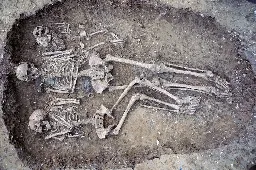Archaeologists uncover the real story of how England became England
Archaeologists uncover the real story of how England became England
New research is revealing how the Sceptered Isle transformed from a Roman backwater to a mighty country of its own

Since the Renaissance, scholars have been engaged in a curious and feverish debate over where the people who populate England came from. Did they arrive as conquerors, as Gildas would have it? Or by a more gradual and peaceful migration? The answer matters because it provides an explanation for a perplexing reality: In a remarkably short three centuries after the Roman occupation, Britain was transformed into a dramatically different kind of place.
Under Roman administration, Britain was largely urban. People lived in tile-roofed stone buildings in towns connected by roads; they boasted a standing army and a coinage system. Native Britons spoke an indigenous Celtic language and probably some Latin. By the 700s, things had changed entirely: Inhabitants lived mostly in country hamlets in wood-and-thatch homes resembling Grubenhäuser, those partly sunken houses typical of northern Germany and southwest Denmark. With the empire gone, many workers, from builders to vintners to smiths to perfumers, simply no longer had a market for their products or services, so the only way to survive was subsistence farming. In this way, the Britons produced what they needed, and they bartered for the rest. The things they made, jewelry or pots, drew on both continental and indigenous traditions but were uniquely theirs. Most striking, they had created a new national identity and were speaking a new language, the earliest form of English.
But exactly how was the Roman Britain of 400 transfigured into the radically different country we now call England—all in less than 300 years? Recent scholarship presents an intriguing, and persuasive, case for the migration hypothesis. Analyzing DNA from hundreds of Anglo-Saxon-era bones in England and in northwest Europe, a paper in the journal Nature has concluded that as much as 76 percent of ancestry in eastern medieval England came from what is now Germany and Scandinavia. Meanwhile, archaeologists continue to uncover artifacts in Anglo-Saxon cemeteries that arguably weigh heavily against the theory of origin-by-conquest; indeed, no graves suggesting wealth have been linked to any purely Germanic settlers. The findings suggest something rather remarkable: that some of the most precipitous shifts in social and material culture can come not from war but from peace.
...
If there had been a conquest and a resulting upper class of Germanic warriors, you’d expect to see two distinct genetic pools. Not so. “This paper is paradigm-shifting,” says Oxford archaeologist Helena Hamerow, who reviewed the group’s work for Nature. “Clearly the native Britons were not nearly exterminated and/or driven out,” she adds, “but many must have intermarried with and lived amongst immigrants and their descendants.”